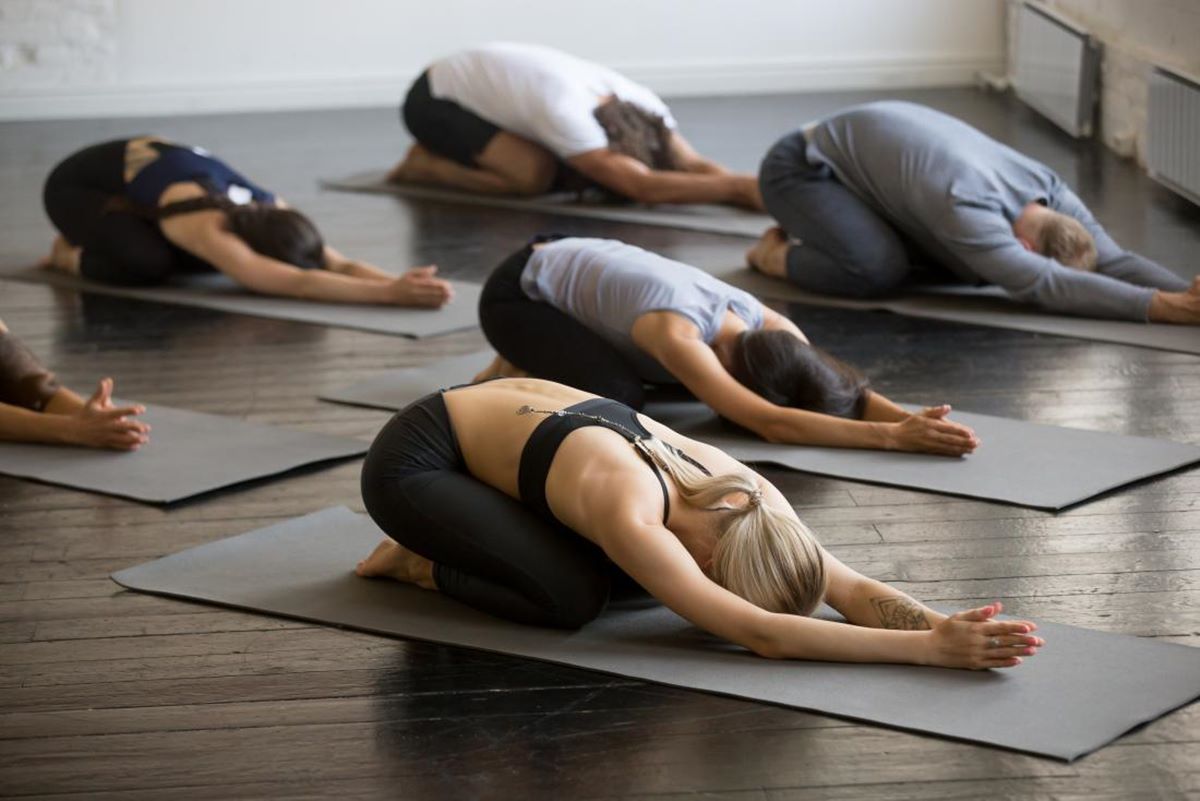

Featured
What Is Exercise
Published: September 30, 2023
Learn what exercise is and how it can improve your health. Discover the benefits of incorporating featured workouts into your fitness routine.
Introduction
Welcome to the world of exercise! Whether you are a fitness enthusiast or a beginner exploring the benefits of physical activity, this article will provide you with a comprehensive understanding of what exercise is and how it can positively impact your life. Join us as we delve into the definition of exercise, its various types, the benefits it offers, and practical tips on how to incorporate exercise into your daily routine.
Exercise is more than just a buzzword in the health and wellness industry. It plays a crucial role in maintaining overall well-being, both physically and mentally. Engaging in regular exercise not only helps strengthen your muscles and improve cardiovascular health but also boosts mood, reduces stress levels, and enhances cognitive function.
Whether you’re a gym aficionado, a sports enthusiast, or simply someone looking to incorporate more movement into your daily life, exercise comes in various forms to suit different preferences and goals. From high-intensity workouts to calming yoga sessions, there is something for everyone.
Throughout this article, we will explore the different types of exercise and their benefits. We will also provide guidance on how to get started with exercise if you’re new to it, as well as offer practical tips on how to maintain an exercise routine for long-term success. Let’s dive in and discover the incredible world of exercise!
Definition of Exercise
Exercise can be defined as any physical activity that involves exertion of the body’s muscles with the goal of improving health, fitness, or performance. It is a structured or repetitive movement that targets specific muscle groups or the body as a whole. The primary purpose of exercise is to enhance physical strength, endurance, flexibility, and overall well-being.
Exercise is not limited to traditional gym workouts. It encompasses a wide range of activities such as running, swimming, cycling, weightlifting, yoga, dancing, and team sports. The key element across all forms of exercise is intentional movement with the intention of improving one’s physical abilities and overall health.
Regular exercise provides numerous benefits to the body and mind. It strengthens the cardiovascular system, increases muscle tone and strength, improves bone density, and enhances flexibility. Exercise also plays a crucial role in weight management, as it helps burn calories and build lean muscle mass.
Beyond the physical benefits, exercise has a profound impact on mental health. It releases endorphins, often referred to as “feel-good” hormones, which elevate mood and reduce stress and anxiety. Exercise has also been shown to improve cognitive function, memory, and concentration.
The intensity and duration of exercise can vary based on an individual’s fitness level, goals, and preferences. It is important to listen to your body and gradually increase the intensity and duration of your workouts to prevent injury and allow for proper recovery.
Overall, exercise is an essential component of a healthy lifestyle. It is not only an effective way to improve physical fitness but also a powerful tool for improving mental well-being. By incorporating regular exercise into your routine, you can experience the countless benefits it has to offer and embark on a journey of lifelong health and vitality.
Types of Exercise
Exercise comes in various forms, each offering unique benefits and targeting different aspects of physical fitness. Understanding the different types of exercise can help you find activities that align with your interests and goals. Here are some common types of exercise:
- Aerobic Exercise: Also known as cardiovascular exercise, this type of exercise focuses on increasing the heart rate and improving overall cardiovascular health. It includes activities like brisk walking, running, swimming, cycling, and dancing.
- Strength Training: This type of exercise aims to build muscular strength and endurance by using resistance, such as weights or resistance bands. It includes exercises like weightlifting, bodyweight exercises, and using weight machines at the gym.
- Flexibility Training: Flexibility exercises aim to increase the range of motion in joints and improve overall flexibility. Activities such as yoga, Pilates, and stretching routines help enhance joint mobility and reduce the risk of injury.
- Balance and Stability Training: This type of exercise focuses on improving balance, stability, and coordination. It includes exercises like Tai Chi, balance boards, and specific yoga poses that challenge your equilibrium and body control.
- High-Intensity Interval Training (HIIT): HIIT involves alternating between short bursts of intense exercise and periods of recovery. This type of training can be an efficient way to improve cardiovascular fitness and burn calories in a shorter amount of time. It can involve exercises like sprinting, jumping jacks, burpees, and kettlebell swings.
It’s important to choose a variety of exercises to engage different muscle groups and keep your workouts interesting. Incorporating a blend of aerobic, strength, flexibility, and balance/stability training can lead to a well-rounded fitness routine.
You don’t necessarily have to stick to one type of exercise exclusively. Many activities combine elements of different types, such as yoga, which incorporates strength, flexibility, and balance training. Experimenting with different activities can help you discover what you enjoy and what works best for your body.
Remember, the key is finding activities that you enjoy and that fit into your lifestyle. By incorporating a mix of exercises, you can meet your fitness goals, stay motivated, and experience the benefits of a diversified fitness routine.
Benefits of Exercise
Regular exercise offers a multitude of benefits for both the body and mind. Whether you’re looking to improve your physical fitness, manage your weight, reduce stress, or boost your mood, exercise has something to offer for everyone. Here are some key benefits of incorporating exercise into your routine:
- Improved Cardiovascular Health: Aerobic exercises like running, swimming, and cycling help strengthen the heart and improve cardiovascular function. Regular cardio exercise can lower blood pressure, reduce the risk of heart disease, and improve overall heart health.
- Weight Management: Exercise plays a vital role in maintaining a healthy weight. It helps burn calories, build lean muscle mass, and increase your metabolism, making it easier to lose weight or maintain a healthy weight.
- Increased Muscle Strength and Tone: Strength training exercises, such as weightlifting and bodyweight exercises, help build and tone muscles. Strong muscles not only improve physical performance but also support good posture and protect against injuries.
- Improved Flexibility and Range of Motion: Flexibility exercises like yoga or stretching routines improve joint flexibility and range of motion. This can enhance athletic performance, prevent muscle imbalances, and reduce the risk of injuries and muscle strains.
- Enhanced Mood and Mental Well-being: Exercise releases endorphins, also known as “feel-good” hormones, which can boost mood, reduce stress, anxiety, and symptoms of depression. Regular physical activity is associated with improved mental well-being and a better overall quality of life.
- Increased Energy Levels: Engaging in regular exercise can boost energy levels and reduce feelings of fatigue. It improves blood flow and oxygen delivery to the muscles and organs, enhancing energy production and overall vitality.
- Better Sleep: Regular physical activity can promote better sleep quality, helping you fall asleep faster and enjoy deeper, more restful sleep. However, it’s important to avoid intense exercise close to bedtime, as it may interfere with sleep patterns.
- Improved Brain Function: Exercise has been shown to enhance cognitive function, memory, and attention span. It increases blood flow to the brain, promoting the growth of new neurons and improving overall brain health and function.
The benefits of exercise extend beyond physical health. They improve mental well-being, boost self-confidence, and contribute to an overall sense of well-being. By incorporating regular exercise into your lifestyle, you can experience these benefits and enjoy a healthier, happier life.
How to Get Started with Exercise
Embarking on a fitness journey can be both exciting and overwhelming, especially if you’re new to exercise. Here are some steps to help you get started and set yourself up for success:
- Set Clear Goals: Define your fitness goals to give yourself a sense of direction and purpose. Whether you want to lose weight, build strength, improve flexibility, or simply enhance your overall well-being, having clear goals will help you stay motivated and focused.
- Consult with a Healthcare Professional: If you have any pre-existing medical conditions or concerns, it’s important to consult with a healthcare professional before starting an exercise program. They can provide guidance tailored to your specific needs and ensure your safety.
- Start Slow and Gradually Increase Intensity: It’s important to ease into exercise to avoid injury and allow your body to adapt. Begin with low-impact activities or shorter workout sessions and gradually increase the duration and intensity over time.
- Find Activities You Enjoy: Explore different types of exercise to find activities that you genuinely enjoy. Whether it’s a group fitness class, outdoor activities, or individual workouts, choosing activities that you find fun and engaging will increase the likelihood of sticking with them long-term.
- Create a Schedule and Make it a Habit: Set aside dedicated time for exercise in your weekly schedule and treat it as a non-negotiable appointment. Consistency is key to building a habit, so aim to exercise on most days of the week, even if it’s for shorter durations initially.
- Start with Bodyweight Exercises: If you’re new to strength training, start with bodyweight exercises that use your own body as resistance. Exercises like squats, lunges, push-ups, and planks can be done anywhere, require no equipment, and are effective for building strength and stability.
- Listen to Your Body: Pay attention to your body’s cues and adjust your workout intensity or modify exercises as needed. It’s important to push yourself within your limits but also give yourself permission to rest and recover when necessary.
- Stay Hydrated and Fuel Your Body Properly: Hydration is essential for exercise performance and recovery. Drink water before, during, and after your workouts. Additionally, fuel your body with nourishing foods that provide the energy and nutrients needed to support your physical activity.
Remember, getting started with exercise is a personal journey, and it’s important to listen to your body and find what works best for you. Celebrate small victories along the way, stay consistent, and embrace the process of improving your fitness and overall well-being.
Tips for Maintaining an Exercise Routine
Starting an exercise routine is a great step towards a healthier lifestyle, but the true challenge lies in maintaining it for the long term. Here are some helpful tips to help you stay consistent and motivated in your exercise routine:
- Set Realistic and Achievable Goals: Set goals that are specific, measurable, attainable, relevant, and time-bound (SMART goals). This will give you something to work towards and track your progress.
- Find an Accountability Buddy: Exercising with a friend or joining a group fitness class can provide a sense of accountability and make workouts more enjoyable. Having someone to share your progress, challenges, and successes with can help you stay motivated.
- Choose Activities You Enjoy: Find physical activities that you genuinely enjoy. When you enjoy what you’re doing, it becomes easier to stay committed and incorporate exercise into your daily routine.
- Make it a Habit: Consistency is key when it comes to maintaining an exercise routine. Schedule your workouts at the same time each day or week, making them a non-negotiable part of your routine.
- Mix It Up: Avoid boredom and keep your workouts interesting by incorporating a variety of exercises and activities. Try new workouts, explore different classes, or experiment with outdoor activities to keep yourself engaged and motivated.
- Track Your Progress: Keep a record of your workouts, whether it’s a fitness journal, a tracking app, or a wearable device. Seeing your progress can be incredibly motivating and serve as a reminder of how far you’ve come.
- Make Exercise Convenient: Reduce barriers to exercise by making it convenient and accessible. Choose a gym or fitness facility close to your home or workplace, lay out your workout clothes the night before, or have a home workout space available for days when you can’t make it to the gym.
- Reward Yourself: Celebrate milestones and achievements along your fitness journey. Treat yourself to a massage, a new workout outfit, or a healthy meal after reaching a specific goal. Rewards can help reinforce positive behavior and make the process more enjoyable.
- Listen to Your Body: Pay attention to your body and prioritize rest and recovery when needed. Overtraining can lead to fatigue and increased risk of injury. Give yourself time to rest and rejuvenate to ensure long-term success.
- Be Flexible: Life can sometimes throw unexpected challenges or disruptions in your routine. Instead of getting discouraged, be flexible and find creative ways to incorporate physical activity into your day, even if it means adjusting your schedule or trying shorter workout sessions.
Remember, maintaining an exercise routine is a continuous process. Patience, commitment, and a positive mindset will help you stay motivated and enjoy the physical and mental benefits of regular exercise.
Common Mistakes to Avoid in Exercise
While exercise is incredibly beneficial, it’s important to approach it with proper technique and mindset to prevent injuries and maximize results. Here are some common mistakes to avoid in exercise:
- Overtraining: Pushing yourself too hard and not allowing adequate rest and recovery can lead to overtraining. This can result in fatigue, decreased performance, increased risk of injury, and burnout. Listen to your body and give yourself time to rest and recover.
- Poor Form and Technique: Incorrect form and technique can compromise the effectiveness of an exercise and increase the risk of injury. Work with a qualified fitness professional, watch instructional videos, and focus on maintaining proper form to get the most out of your workouts.
- Skipping Warm-up and Cool-down: A proper warm-up prepares your body for exercise by increasing heart rate, circulation, and flexibility, while a cool-down helps to gradually lower heart rate and stretch tight muscles. Skipping these essential components can lead to muscle strains and other injuries.
- Ignoring Proper Breathing: Breathing plays a crucial role in exercise, providing oxygen to working muscles and helping to stabilize the core. Pay attention to your breathing during workouts, exhaling during exertion and inhaling during relaxation phases.
- Not Listening to Your Body: It’s important to pay attention to any pain, discomfort, or unusual sensations during exercise. Pushing through pain or ignoring warning signs can lead to serious injuries. If something doesn’t feel right, modify or stop the exercise and seek advice from a healthcare professional if needed.
- Not Including Strength Training: Many people focus solely on cardiovascular exercises and neglect strength training. Incorporating resistance training into your routine is essential for building lean muscle mass, boosting metabolism, and supporting overall strength and functional fitness.
- Setting Unrealistic Expectations: Setting unrealistic goals or expecting immediate results can lead to frustration and disappointment. Remember that progress takes time and consistent effort. Set realistic goals and celebrate the small victories along the way.
- Relying Solely on Exercise for Weight Loss: While exercise plays a crucial role in maintaining a healthy weight, it is important to remember that diet and nutrition also play a significant part. Focusing solely on exercise without paying attention to your eating habits may hinder your weight loss efforts.
- Not Incorporating Variety: Doing the same exercises day after day can lead to boredom and plateauing. Incorporate a variety of exercises and activities to challenge your body in different ways and keep your workouts fresh and exciting.
- Comparing Yourself to Others: Everyone’s fitness journey is unique, and comparing yourself to others can be discouraging and counterproductive. Focus on your progress, listen to your body, and celebrate your own achievements, irrespective of others’ accomplishments.
Avoiding these common exercise mistakes can help you stay safe, prevent injuries, and make the most of your workouts. Remember to always prioritize your safety, listen to your body, and seek guidance from professionals when needed.
Conclusion
Exercise is a powerful tool that can transform your physical and mental well-being. By incorporating regular physical activity into your routine, you can experience a multitude of benefits, including improved cardiovascular health, increased strength and flexibility, enhanced mood, and better overall quality of life.
Throughout this article, we explored the definition of exercise and the various types available, from aerobic and strength training to flexibility and balance exercises. We discussed the numerous benefits of exercise, such as improved cardiovascular health, weight management, increased muscle strength, and enhanced mental well-being.
To get started with exercise, we recommend setting clear goals, finding activities you enjoy, and creating a routine that works for you. By staying consistent, being flexible, and listening to your body, you can maintain an exercise routine for the long term.
It’s important to avoid common exercise mistakes, such as overtraining, poor form, neglecting warm-up and cool-down, and comparing yourself to others. By being mindful of these pitfalls, you can minimize the risk of injury and maximize the effectiveness of your workouts.
Remember that exercise is a personal journey, and what works for one person may not work for another. Experiment with different activities, find what you enjoy, and make exercise a part of your lifestyle. Celebrate the small victories along the way and keep pushing yourself to reach your goals.
So, whether you’re a seasoned fitness enthusiast or just starting your fitness journey, embrace the power of exercise and witness the transformative effects it can have on your body, mind, and overall well-being. With dedication, consistency, and a positive mindset, you can unlock your full potential and enjoy a healthier and happier life.









